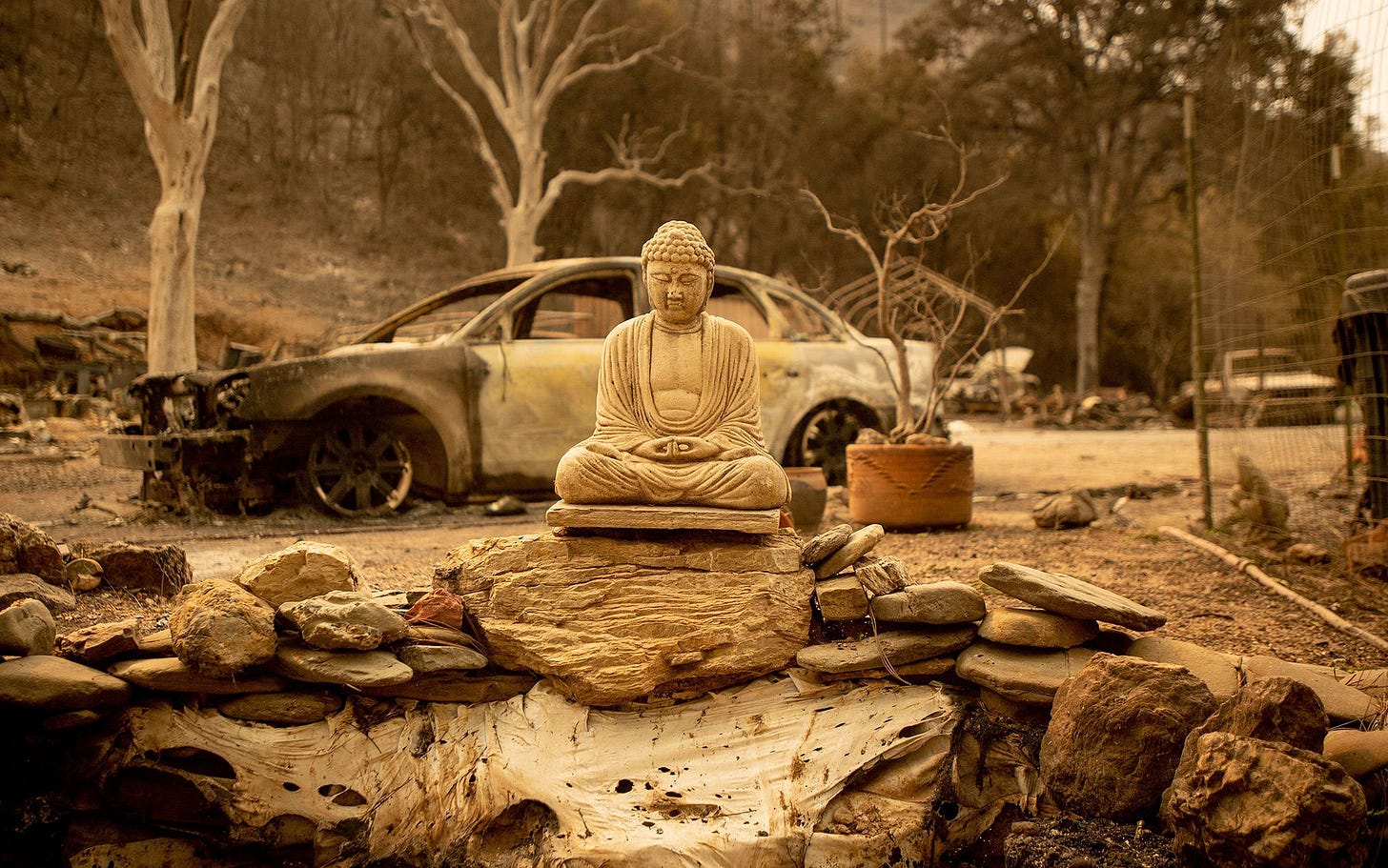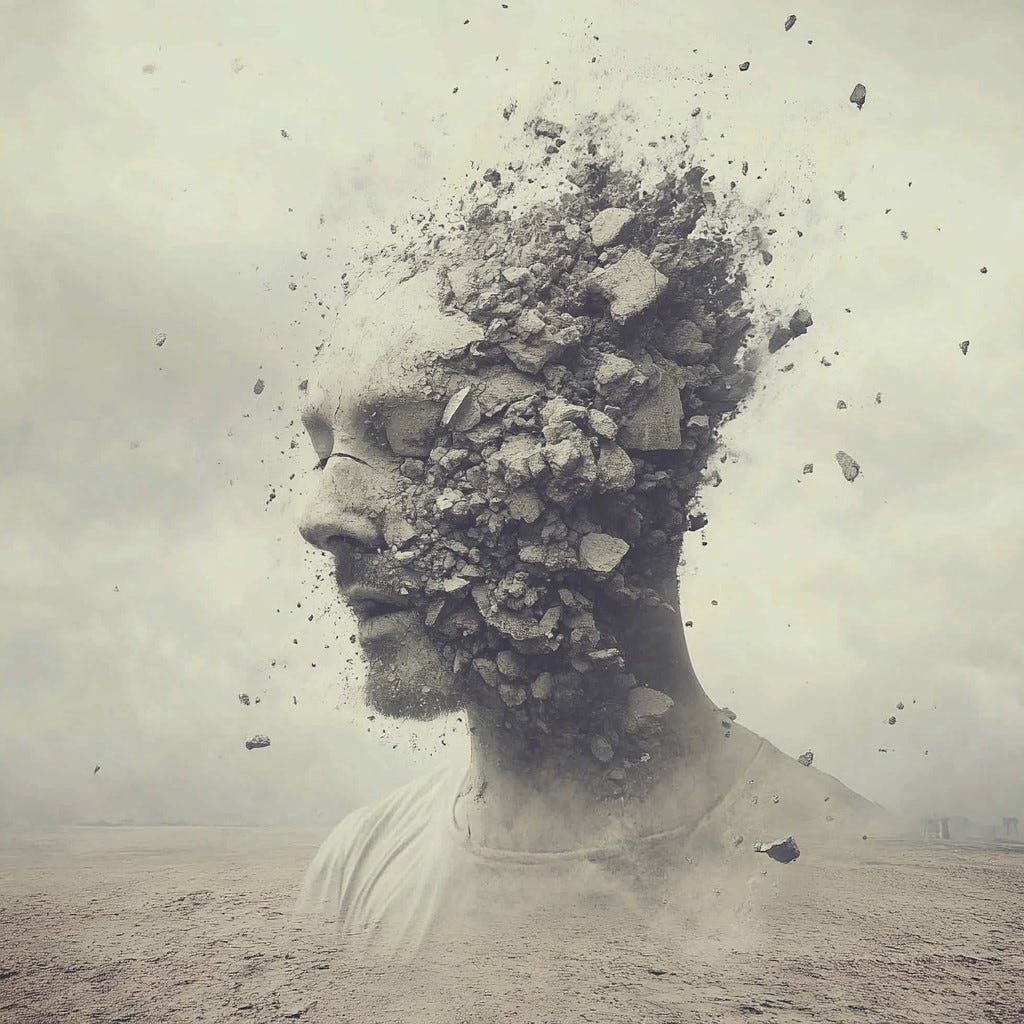Buddhism has caught the fancy of the American population for the past 60-70 years. Its caught mine too frankly. Of all the paths one can walk as an Occultist, I find the Buddha’s metaphysics and praxis both inspired, and yet wholly pragmatic and accessible. If you had to force me into a corner at gun point and demand a declaration of a mainline faith, I would profess Buddhism in as much as one can actually do so in today’s world (more on this to come). Buddhist epistemology of mind and consciousness are so advanced that for years to come science will slowly come to the same conclusion about reality Buddha arrived at over 2,500 years ago. Non-local, interdependent consciousness is reality.
Buddhism is everywhere in America, or at least the smell of it is everywhere. Basic Buddhist principles have permeated into so many facets of our everyday life, they are no longer recognizable as being Buddhist. Kind of like saying ‘God Bless You’ when you sneeze. Yet like everything in America, self-identified Buddhist culture is becoming polarized. On one end there are radically traditional (RAD TRAD), wats, temples and centers with relatively small numbers of students adopting a cultural-centric approach to the Buddhist path. These organizations offer what amounts to an escapist cos-play experience, allowing the student a spiritual distraction into the Thai, Tibetan, Japanese, Chinese, Korean cultural experiences with Buddhist tendencies. On the other end of the spectrum, there are corporate, “modern” or “secularized” movements which claim to discard not only the cultural baggage of the RAD TRADS, but also claim to abscond from any form of supernatural or spirit based models of Buddhism, lazily citing these traditions as outdated superstitions. These corporate movements tend to package and sell Buddhism as a commoditized solution to the modern world. A product which is efficient, accessible and can radically change one’s life. Some even claim to be able to lead the enthusiast to some level of enlightenment relatively quickly without the trappings of having to be Buddhist in any traditional sense of the word.
And it is here, my friends, within this polemic culture of radically juxtaposed approaches to American Buddhist path is the rub. None of these modern-day approaches (Rad-Trad, or Corporate) are authentic Buddhist teachings at this stage in history. Yes, a radical statement and not one often uttered in the frenzy of the Mindfulness marketplace. Yet, for me to make such a statement isn’t opinion, it is actually orthodox Buddhist doctrine and dogma. Doctrine and dogma that no one wants to acknowledge. But in-fact, the Buddha himself, according to the earliest records, declared this more than once and his words come piercing the consumerist fog of modern American materialist life like a dagger of wisdom. The Buddha, in his infinite wisdom and understanding of human dysfunction decided to delete his legacy, his doctrine, his life’s work by installing an expiration date; a self-destruct code within his teachings. The wizard preemptively beat the charlatans and scoundrels to the cosmic punch and no one wants to talk about it.
Not today, Mara.
He gave this warning to his closest students in the Samyutta Nikaya.
“Bhikkhus, there will come a time when the True Dhamma will disappear. There will be a counterfeit Dhamma that will arise in the world.”
In these words, we see the Buddha fire a shot across the bow of history to get ahead of the pending crisis we can see so clearly today. Some contraries say it was simply skillful means; an attempt to get his students to take their current incarnation seriously and not waste it for some future bid down the road. Yet any astute so-called Buddhist today can recognize the presence these counterfeit goods. Sogyal, Mipham, Shimano, Sasaki, Maizumi, Suya Das, Dennis Genpo, Levine, Trungpa and his successor Tenzin and so many other known and un-known. All teachers with some level of Buddhist vows, who have sold seekers a bill of fake goods or at the very least fell down in their efforts to be exemplary.
But, to drive the matter home, the Buddha wasn’t done with this one, warning. This concern plagued him and his early disciples. This isn’t one of those situations where-in a couple pages have been extracted from thousands for political or commercial purposes. The Buddha’s concern about the future of Buddhism and its inevitable corruption is echoed across 6 different Pali Cannons and Sutras totaling hundreds of pages:
· Samyutta Nikaya (Pali)
· Saddharmapuṇḍarīka Sūtra (Pali)
· Anguttara Nikaya (Pali)
· Digha Nikaya (Pali)
· Mahaparivana Sutra (Sanskrit)
· Lalitavistara Sutra (Sanskrit)
In addition, the great Buddhist Saint Nagarjuna (who some revere as the 2nd Buddha and who’s philosophical works are the foundation of many east-Asian lineages today) was so concerned about the future integrity of Buddhism, he gave an entire commentary on the degradation and eventual deletion of Buddhism in an eschatological tour de force work, the Perfection of Wisdom which dates to the 2nd-3rd century CE .
In this work, Nagarjuna plainly summaries his assessment:
As time passes, those who wear the robe will seek profit, engage in disputes, and abandon the true path. The Dharma will remain only in name, like a lamp running out of oil. Though texts may exist, those who truly understand them will be rare, and the world will be covered in darkness
~Mahāprajñāpāramitā Śāstra
Sound familiar to anyone. Are we getting close? May I interest you in a free download of Calm to your phone? Or perhaps sell you on a three-week life-changing retreat where in you can penetrate the Jhanas according to new Mind Maps developed by our non-profit corporation (based on the Cannon of course) ? Or perhaps we can really dive in and set out on a psychedelic journey where in you can violate the most basic principle of Buddhist discipline by intoxicating yourself and becoming “awake” all before bed time on a Friday PM?
Prophecy fulfilled.
Now, for those of you devoted meditators who are surely feeling your sphincter pucker as you read these words, please take heart and listen closely. The Buddha’s declaration about the end of the Dharma is by no means a qualitative assessment on your preferred lineage, tradition, teachers of the likely countless hours of meditation you have accumulated. It is a purely quantitative observation grounded in the teachings of the Buddha. The statement “no true Buddhism exists today” is not an argument about ethics or an emotive assessment of some scandalized Lama/ Roshi/ Bhanti (there are many to be sure), and who said “what” to “whom”, or “who” did “what” to “whom”. This is a much less personal declaration. This is about orthodox Buddhist Aeonics; a Dharma eschatology if you will, which dictates that the further out from the life of Buddha you look, the higher the probability of scandal, corruption and eventual extinction of the Dharma.
"Thus, monks, in the future, the true teachings will disappear. Just as when there is no more true gold, counterfeit gold will be accepted as real, so too, when the true teachings disappear, these counterfeit teachings will arise, and they will be mistaken for the true Dhamma."
~Samyutta Nikaya
This dire prediction of the Buddha was so concerning to his followers that it was later expanded upon in a more methodical fashion in what has become known in Orthodox Buddhism as Three Periods of the Dharmas’ decline. A generational road map, to assist the well-meaning traveler in navigating the centuries as they go by. Initially introduced by the Buddha and expanded upon by Nagarjuna in the 3-4 Century CE elucidates the Three Periods of Decline and eventual dissolution of the Buddha’s teaching take place in Phases over thousands of years.
According to doctrine, the decline and eventual extinction of Dharma will take place as follows:
1) Age of True Dharma: Period of time when the true Dharma of the Buddha was practiced. Monks upheld the required discipline, and enlightenment was easily attainable.
a. Time Period: 500 BC-6 Century CE
2) Age of Dharma LARPING: Period in which outward forms of Dharma remain, but inner practice and corruption is on the rise. Enlightenment is still attainable, but rare. People are pretending ; playing a role.
a. Time Period: 6th Centry CE to 16th Century (Medieval times)
3) Age of Dharma Extinction: Period in which the true meaning of Dharma is lost all together. Charlatans and false lineages are rampant while true lineages are unknown. Enlightenment is no longer possible.
a. Time Period: 16th Century-Today… with another 8,500 years to go!
~Mahāprajñāpāramitā Śāstra
As you read this, realize that you are living in the Dharma Ending Age. To put this often forgotten or ignored pearl of Buddhist dogma in stark historical perspective, this prophecy renders the collective wisdom of many modern-day Buddhist lineages impotent; Dogen, Hakuin, Ajahn Chan, Longchenpa, Marpa, Sawdaw Pandita and perhaps even Bodhidharma himself taught a path that was a a mere semblance of the original Dharma according to the Buddha himself! None of it is true Dharma according to Buddhist doctrine. Yet that small and inconvenient fact has not stopped the continued, building, expansion and propagation of all sorts of manner of things in name of the Buddha.
In all of this, I am reminded of this famous quote
“It is difficult to get a man to understand something if his salary depends on him not knowing it.”
~Cannot recall who
But let’s not be sad. I haven’t spilled all this ink with the intention of bumming you out. Quite the contrary. With all of the shallow commoditized Dharma products hitting the market, and the ranks of non-profits being filled with “Chief Contemplative Officers” and your email being filled with solicitations for a shamanic dharma journey and the constant barrage of “new and life changing wisdom” waiting for you just around the cash register….My friend, I have given you one less thing to worry about. Knowing its all bullshit is Buddhism in practice. Knowing this truth without hesitation, is perhaps the most Buddhist action one can earnestly embark upon in today’s world. So please, don’t take my word for it, but take the words on the Buddha himself to heart. Hear his wisdom as his words come back to us as an echo from timeless awareness.
Liberation Through Darkness,
Psuedo Agrippa






Wasn’t there some comment that if you see Buddha walking down the road, kill him. Was it Zen Buddhism? I think the idea of the comment aligns with your post. If we look for Buddha outside of ourselves then we will end up killing the Buddha within us.
If you were to summarize in 1-2 sentences the point of your piece, what would it be? If it's the fact that there's a lot of bullshit out there, yeah sure, you're right, but why would you write about it at such length when you could be using the time to write stuff you've discovered for yourself that's helpful to people?
Don't you feel there's value in trial and error? Doesn't one accumulate forms of knowledge through mistake also? Leave people to go through their journeys and offer them help without insistence so the right information, provided you indeed wield it, for when the time is right.
I can't imagine the existence of spiritual misguidance to be a phenomenon isolated to our times - it's been there throughout history. The Buddha left many tantras as teachings in my understanding, one of which I was able to get my hands on through the very trial-and-error process referenced earlier, which means his words weren't deleted, they're just esoteric, as they've always been.